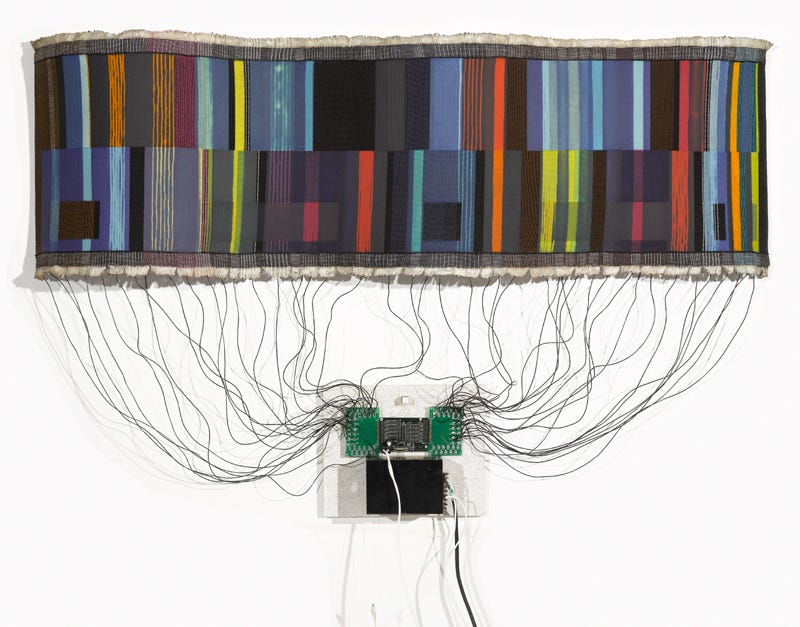Three textiles to enjoy
Textiles, computations and life updates.
Since I arrived in Bogota I’ve been hard at work training for the roller derby worlcup in Austria next July, where I’ll be competing as skater and co-captain of the Colombian national team. Training is going well, requires a lot of dedication and commitment, in particular during the weekends, hence my disappearance from last week newsletter. (Btw, if you want to support our team, here’s a link for donations). This week I’m back, sharing a selection of three artworks from my thread about textiles and computation on the platform formerly known as twitter, that I recreated and expanded as an are.na channel.
As a big fan of both textiles (I do knitting and hand embroidery) and computers (duh), I started reading about the connection of the two and found fascinating the story of the jacquard loom and the multiple ways in which artists weave together (pun intended) electronics with thread arts. Some of my favorites involve conductive yarn, weaving led fabrics, and embroidered chips. Besides this, I love art from living artists and women, and there’s an unsurprisingly amount of them in the electronic textiles field.
1 – Replica of a Chip, Marilou Schultz, 1994

Schultz is a Navajo math teacher and artist that comes from a long lineage of weavers. A big part of why I love textiles is because normally people learn it from their mothers or grandmothers, it feels like something shared between the family for generations tracing back to the beginning of times and that’s the case of Schultz. She started weaving at a young age, eventually started working selling her rugs and then eventually making it into big exhibitions of her work.
This artwork was commissioned by Intel in 1994, and it is so accurate that it is possible to know exactly which Pentium computer circuit board it represents (P54C). There’s also a reference to the history behind the Navajo women assembling circuit boards at an intel factory. If you’re interested, here’s a link to an article about this fascinating piece, including technical details (and diagrams!) of this and other embroidered chip pieces from Schultz.
2 – Maggie Orth; 100 Electronic Art Years, 2009

Orth is an artist and technologist that helped created the field of e-textiles. Groundbreaking is merely the beginning of how you can describe her work. She’s very critical about technology (I wonder what she thinks about current state of software and AI) and this all is visible in her work. She has multiple fascinating pieces on her website, including incredible diagrams as well.
I enjoy thinking about time and consequently works of art where time and interactivity play an important factor. That’s why I like this one, it is made out of programmable color-changing textiles and the viewer plays a part in how the piece changes. With the observer as a key part, Orth creates an interface for the piece to deteriorate, intentionally, so we can think about decay in technology, which is actually a rare topic to think about but ubiquitous, as I see every time I clean my old bookmarks and find multiple 404s. There’s a lot of bravery involved in making a piece that is meant to die and stop working, and it is fascinating as an artist to make the conscious choice of embracing impermanence and reflect on obsolescence and decay in technology and in art.
3 – KOBAKANT; Knit speakers
KOBAKANT is an art collective formed by Hannah Perner-Wilson and Mika Satomi, and as per their website: “KOBAKANT believes technology exist to be hacked, handmade, and modified by everyone to better fit our personal needs and desires”. I find this statement particularly interesting and provoking for this moment where it feels like we’re going from specific, frustrating and almost unusable software to, maybe, an age where highly customized software is possible and end user programming is the norm. Very millennial of me to say that I miss the MySpace days where we used to learn HTML by playing online with our friends and I really hope software can be fun and personal again.
It was really hard to choose just one piece, they’re incredibly prolific, I love their explanatory articles and workshops. I suggest falling into the rabbit hole that is their website, specially check the part about the e-textiles materials. I decided to show here the knit speakers, because it showcases a few things that I love: it is wearable, functional, and beautiful knitting in wire. I also love the name they chose for their DIY explorations: “How to get what you want” in all caps feels very motivating to me.
As I write this I’m in route to SF for Config, so if you’re there, say hi!
That’s all for today, thank you so much for reading and please leave a comment if you know any textile + computation work that I’d love.
Have a great week!




